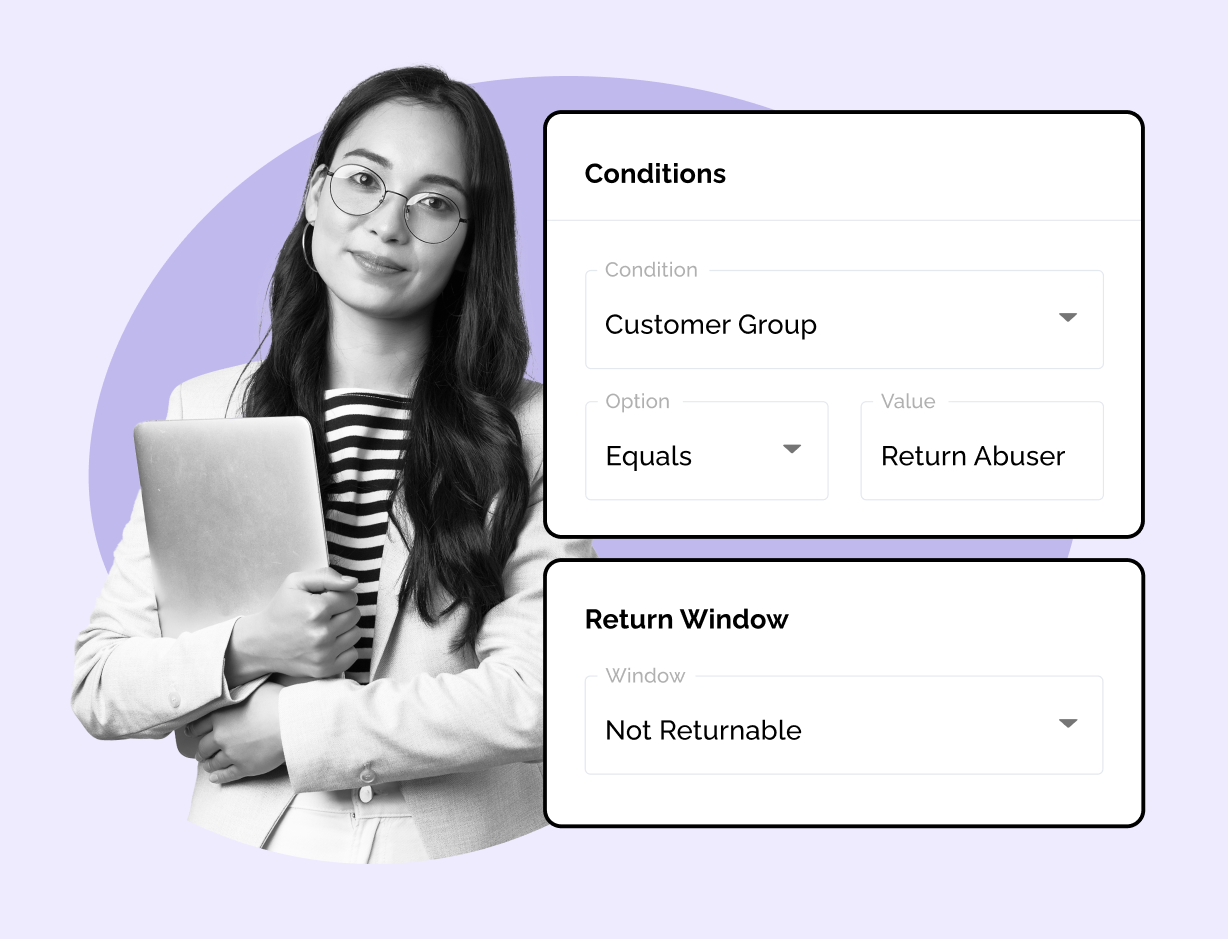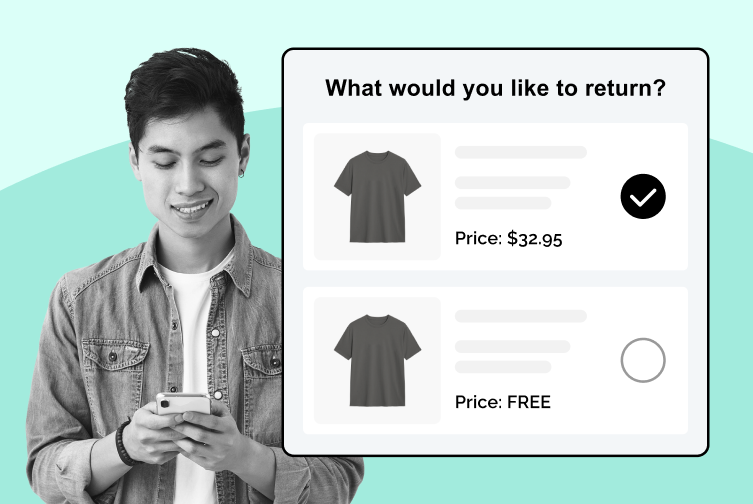
How to Turn Returns Page Into a Revenue Driver
Discover effective strategies to prevent return promo abuse with smart logic. Enhance your business’s integrity!
Shipping, Tracking & Notifications
Boost customer experience and reduce support tickets
Realtime order and shipment tracking
Proactive order and shipping notifications
AI-Enhanced Discounted Labels
Predictive pre-purchase estimated delivery dates
Self-Serivce branded order tracking
Effortless experience delivered
Identify and Resolve Order Issues
Realtime order and shipment tracking
Make returns profitable and delight customers
Flexibility to define any return destinations & conditions
Simplify returns for your customers and team
Incentivize exchanges over returns
Returns management made easy for your team
Returns management made easy for your team
Easy claims and smart upsells
Understand why your customers are returning
In-Store & Curbside Pickup
Unify the online and the in-store experience
Hassle-free pickup experience for customers
In-Store dashboard to keep operations streamlined
In-Store and Online orders unified
Drive foot-traffic to your stores
Shipping, Tracking & Notifications
Boost customer experience and reduce support tickets
Realtime order and shipment tracking
Proactive order and shipping notifications
AI-Enhanced Discounted Labels
Predictive pre-purchase estimated delivery dates
Self-Serivce branded order tracking
Effortless experience delivered
Identify and Resolve Order Issues
Realtime order and shipment tracking
Make returns profitable and delight customers
Flexibility to define any return destinations & conditions
Simplify returns for your customers and team
Incentivize exchanges over returns
Returns management made easy for your team
Returns management made easy for your team
Understand why your customers are returning
In-Store & Curbside Pickup
Unify the online and the in-store experience
Hassle-free pickup experience for customers
In-Store Dashboard to keep operations streamlined
In-Store and Online orders unified
Drive foot-traffic to your stores
Boost customer experience and reduce support tickets
Realtime order and shipment tracking
Proactive order and shipping notifications
AI-Enhanced Discounted Labels
Predictive pre-purchase estimated delivery dates
Self-Serivce branded order tracking
Effortless experience delivered
Make returns profitable and delight customers
Flexibility to define any return destinations & conditions
Simplify returns for your customers and team
Incentivize exchanges over returns
Returns management made easy for your team
Equip your team for precise return checks.
Easy claims and smart upsells
Understand why your customers are returning
Unify the online and the in-store experience
Hassle-free pickup experience for customers
In-Store Dashboard to keep operations streamlined
In-Store and Online orders unified
Drive foot-traffic to your stores
Find the answer to all your questions
Take a step by step trip through our functionality to see how we can improve your ecommerce processes.
Explore the most comon questions about WeSupply
Calculate the ROI that WeSupply can bring you
Request a no strings attached review of your current shopping experience and missed conversion opportunities
Read actionable articles on how to optimize your post-purchase experience and decrease support tickets
Get inspired by stories of how our customers implemented an effortless post-purchase experience
Wondering if WeSupply is a good fit for you? Read through our use cases to see how we can help you increase conversion & improve CX!
A Deep Dive into Top Companies' Order Tracking & Returns Strategy
Find the answer to all your questions
Explore the most comon questions about WeSupply
Calculate the ROI that WeSupply can bring you
Request a no strings attached review of your current shopping experience and missed conversion opportunities
Take a step by step trip through our functionality to see how we can improve your ecommerce processes.
Read actionable articles on how to optimize your post-purchase experience and decrease support tickets
Get inspired by stories of how our customers implemented an effortless post-purchase experience
A Deep Dive into Top Companies' Order Tracking & Returns Strategy
Wondering if WeSupply is a good fit for you? Read through our use cases to see how we can help you increase conversion & improve CX!

Return fraud, sometimes referred to as returns fraud, has become a significant challenge for the retail industry, impacting both ecommerce and brick-and-mortar businesses. According to the National Retail Federation, retail return fraud accounted for an estimated $101 billion in losses in 2023 alone a staggering figure that highlights the scale of the problem. This type of fraud occurs when individuals exploit return policies to illegitimately obtain refunds or store credit, often through deceptive tactics such as receipt fraud, empty box fraud, and returning stolen merchandise.
Retail return fraud can take many forms, from box fraud where an empty box is returned instead of the purchased product to the use of fake or altered receipts to obtain refunds. Some fraudsters even attempt to return stolen merchandise, further complicating the returns process and increasing financial risk for retailers. These schemes not only erode profit margins but also drive up operational costs and processing fees, making it harder for businesses to offer flexible return policies that foster customer loyalty.
To combat return fraud effectively, retailers must understand the various ways fraudsters exploit the system and implement robust fraud detection strategies. Leveraging fraud detection software, refining return policies, and staying informed about emerging threats are essential steps in protecting your bottom line. By prioritizing fraud prevention, retailers can maintain customer trust, support legitimate returns, and ensure a positive customer experience ultimately strengthening their reputation and long-term success in the retail industry.
Return fraud is one of the most overlooked threats to ecommerce profitability. While returns are a normal part of doing business online, fraudulent returns can quietly eat away at your bottom line. Whether it’s a customer wearing an outfit once before returning it (wardrobing), scammers swapping real products for counterfeits, or refund fraud schemes, return fraud can take many forms all of which are often committed for personal gain and cost money, time, and trust.
In today’s competitive ecommerce landscape, brands work hard to offer flexible, hassle-free returns to build loyalty. But that same generosity can be exploited. If you don’t have fraud detection systems in place, your business could suffer losses through restocking damaged goods, refunding illegitimate claims, or unknowingly reselling compromised inventory. Preventing fraud also reduces processing costs associated with handling and managing fraudulent returns. Detecting return fraud early is critical not just to stop revenue leaks, but also to protect your customer experience and brand integrity.
Return fraud isn’t a one-size-fits-all problem. Understanding the different tactics used can help you create effective safeguards. Fraudsters often seek full refunds, increasing losses for retailers. Here are some of the most common types:
1. Wardrobing: A customer buys a product often high value items such as designer apparel or electronics uses it briefly, and then returns it as “unused.” Fraudsters aim to receive a full refund after temporary use. This practice is hard to catch without detailed item inspections or usage tracking.
2. Tag/label switching: Some fraudsters swap price tags or product labels to return a cheaper item for the value of a more expensive one. Verifying the original purchase price is important to prevent this scam.
3. Product switching: This involves returning a different item than what was originally purchased. In some cases, the fraudster returns a used, defective, or counterfeit product. This can also involve returning stolen or counterfeit goods.
4. Open box fraud: In this scheme, a customer purchases a discounted open-box or floor model product, then returns the original high-value boxed item while keeping the open-box item for profit. This manipulates discounts and restocking policies.
5. Stolen merchandise returns: People may attempt to return goods they didn’t buy at all, often without a receipt, aiming for store credit or cash.
6. Receipt fraud: Customers might use altered, duplicated, or fake receipts to make unauthorized returns.
7. Return fraud rings: These organized groups use sophisticated tactics to defraud multiple retailers using fake accounts, payment method manipulations, and volume-based attacks.
Recognizing these patterns is the first step toward prevention. Many ecommerce businesses deal with a combination of these schemes, so staying alert to all types is crucial. Final sale items are typically excluded from returns to prevent abuse.
One of the most effective ways to detect fraud is by tracking return behavior over time. While one return doesn’t raise red flags, consistent or extreme patterns often indicate abuse. Some red flags to watch for:
Customers who return a high volume of items relative to purchases
Multiple returns of the same product in different sizes or colors
Frequent “item not as described” or “item defective” claims
Returns initiated shortly after delivery and always right before a return window closes
Multiple return addresses or mismatched shipping and billing info
Frequent returns by the same customer across different locations
The same customer making repeated suspicious return claims
Use your ecommerce platform, CRM, or return management system to segment these behaviors. Assign a return score to customers to assess their return history and flag potentially fraudulent behavior. Reviewing customer history is crucial to identify suspicious activity and track repeat offenders to prevent ongoing abuse. Leverage technology and analytics tools to track return patterns and spot anomalies. Identifying fraud patterns helps distinguish between honest and abusive behavior, so you can respond accordingly without punishing honest shoppers.
Your return policy isn’t just a customer service tool it’s also a line of defense against fraud. A strong policy helps prevent return abuse by setting clear boundaries that discourage tactics like return fraud, stolen merchandise, or receipt falsification. The key is crafting a policy that’s flexible enough to build trust but strict enough to deter abuse. Here are best practices for creating a fraud-resistant return policy:
Set reasonable return windows: Shorter windows (15-30 days) limit time for wardrobing or seasonal abuse.
Require proof of purchase: Digital receipts or order numbers tied to your system reduce the chance of receipt fraud.
Inspect all returned items: Thorough inspections help catch signs of use, damage, or tampering.
Specify return conditions: Make it clear items must be unused, unwashed, and in original packaging with tags intact.
Reserve the right to deny returns: Clearly state that returns outside policy terms or those flagged as abuse may be rejected.
Transparent, consistent enforcement of your return policy discourages fraudsters while still supporting legitimate customers. Display your policy prominently on product pages and checkout to set clear expectations.
Striking the right balance between fraud prevention and a positive customer experience is crucial for any retailer. While it’s essential to detect and prevent fraudulent returns, it’s equally important not to inconvenience legitimate customers or undermine their trust. A well-designed returns process should support honest shoppers while making it difficult for those attempting to commit return fraud.
One effective approach is to implement clear, fair return policies that set expectations for both customers and staff. For example, offering store credit instead of cash refunds for high risk returns can help deter fraudulent behavior without penalizing genuine customers. Technology also plays a key role using fraud detection tools to flag high-risk returns allows retailers to focus their efforts where they’re needed most, minimizing disruption for the majority of shoppers.
Analyzing customer data and return patterns can further enhance fraud prevention efforts. By tracking return frequency, payment methods, and other transaction data, retailers can identify potential fraud and take proactive steps to address it. This data-driven approach helps ensure that legitimate customers continue to enjoy a smooth, hassle-free experience, while those engaging in fraudulent returns are quickly identified and managed.
Ultimately, prioritizing customer satisfaction and loyalty is essential. By offering flexible solutions like store credit, maintaining transparent communication, and using technology to flag suspicious activity, retailers can reduce the risk of return fraud while still delivering a positive customer experience. This balance not only protects your business but also builds long-term trust and loyalty among your customer base.
Technology is your best friend in the fight against return fraud. Advanced fraud detection tools use AI and machine learning to flag suspicious behavior before refunds are processed. Return fraud detection systems leverage AI to identify suspicious activity across multiple retail locations, proactively stopping offenders before they exploit return policies. These systems analyze hundreds of data points in real time, including device IDs, IP addresses, past behavior, purchase history, and return frequency.
Platforms like Signifyd, Riskified, and Forter specialize in ecommerce fraud prevention. They integrate with your site and return management systems to detect patterns humans might miss. For instance, if a customer has a 90% return rate across multiple accounts or frequently uses “item not received” claims, the system can automatically hold the return for manual review.
By automating the identification of high-risk returns, you reduce operational costs and prevent fraudulent refunds. And because these systems continuously learn from new data, they get smarter over time, adapting to new fraud tactics.
Tracking your products throughout their lifecycle can be an effective fraud deterrent. Tools like digital product passports, QR code scanning, and serialized barcodes help verify whether the returned item matches the one sold.
Here’s how it works:
Serialized barcodes: Each item gets a unique identifier that can be scanned upon shipping and return. If the returned item doesn’t match the original serial number, it’s flagged.
Digital receipts: Instead of relying on printed or altered receipts, use email or app-based proof of purchase that ties directly to a customer account.
Tamper-evident packaging or smart labels: Make it harder for customers to repackage used goods or swap labels.
These tools can be implemented across multiple store locations to ensure consistent fraud detection and prevent cross-location return fraud.
These tools can be especially helpful for high-value or frequently returned items such as electronics, shoes, and designer apparel. Not only do they prevent fraud, but they also speed up processing for legitimate returns.
Store employees especially those in fulfillment, customer support, and reverse logistics are your frontline defense against return fraud. Equip store employees with training to spot fraud indicators and escalate them when necessary.
Common return fraud red flags your staff should be aware of:
Returned items missing original packaging or tags
Goods showing signs of wear, use, or alteration
Mismatched product labels, sizes, or colors
Repeated excuses or complaints from specific customers
Train your team to photograph questionable returns, log customer behavior, and coordinate with fraud prevention tools. Creating internal documentation workflows ensures your team acts consistently and that no suspicious activity falls through the cracks.
If possible, build collaboration between your customer service, warehouse, and fraud prevention teams. When everyone shares insights, patterns emerge faster.
You don’t want to punish honest customers in your efforts to prevent fraud. That’s why you need to implement smart deterrents that target abusive behavior while maintaining trust with loyal shoppers. A strong focus on customer success ensures that anti-fraud measures are designed to protect your business without negatively impacting genuine customers.
Here are some strategies:
Charge restocking fees selectively: Apply these only to high-risk items or repeat abusers.
Use store credit instead of refunds: Especially for frequent returners, offering credit can reduce losses.
Offer exchanges as the default: Encourage customers to swap rather than return, lowering refund abuse.
Blacklist serial fraudsters: Block users with suspicious histories from initiating future returns.
These strategies show that you’re watching and managing returns carefully, which alone can discourage would-be fraudsters. However, make sure your policy remains customer-centric. Offer proactive support and flexibility to loyal customers so they still feel valued.
Return fraud doesn’t always come from individual bad actors. Increasingly, ecommerce businesses face threats from organized fraud rings and sophisticated schemes. That’s why it’s important to detect broader fraud signals, including:
Multiple returns from the same IP address under different accounts
Shipping address mismatches or excessive use of PO boxes
High-volume returns in short time frames that deviate from seasonal norms
Abuse of return windows, coupons, or price-match guarantees
Social media posts or forums coordinating return scams
Third-party fraud detection platforms can monitor for these signals, but you can also configure alerts within your ecommerce system. Staying informed on emerging fraud tactics via industry publications, Reddit threads, and ecommerce communities can help you stay one step ahead. Collaborating with industry partners, law enforcement, and other retailers to share intelligence and best practices is essential for strengthening defenses against retail fraud.
No single tool or policy can stop return fraud alone. The best protection comes from a layered approach that combines people, processes, and technology.
Here’s what a comprehensive return fraud prevention strategy might include:
A flexible but firm return policy that sets clear boundaries
Fraud detection software that uses AI and machine learning
Product tracking and serialized packaging for high-risk items
Training programs for warehouse and support staff
A return score or behavior-tracking system for customers
Escalation protocols for suspicious returns
Transparent communication with customers
Measures to address chargeback fraud, which involves customers disputing legitimate charges with their banks, in addition to return fraud
When all these components work together, your business can confidently offer a generous return policy while minimizing the risk of abuse. Most importantly, your legitimate customers still receive a great experience and your bottom line stays protected.
Return fraud doesn’t just chip away at your margins it chips away at your trust in customers. From wardrobing and product switching to receipt fraud and organized return rings, the threat is real. But WeSupply helps ecommerce retailers fight back with automation, smart policies, and real-time analytics that catch fraud before it impacts your profits all while keeping the return experience smooth for your honest shoppers.
Here’s how WeSupply helps you detect and prevent return fraud without compromising customer satisfaction:
Custom Return Rules: Tailor return logic by item value, return reason, or customer behavior to prevent high-risk returns from slipping through.
Confusion-Free Return Windows: Eliminate misunderstandings by clearly defining when return windows begin whether by order date, fulfillment date, delivery date, or even during holiday-specific windows.
Flexible Return Window by Product Type: Set product-specific return windows by SKU, tag, or category to better manage high-risk or seasonal items.
Non-Returnable Item Enforcement: Clearly mark and enforce return restrictions on:
Blocklist Fraudulent Customers: Use email or customer group blocklists to prevent repeat offenders from abusing your return policy.
Tiered Restocking Fees: Apply restocking fees based on how many days have passed since delivery encouraging timely returns and reducing losses.
Charge Restocking Fees for Specific Items: Offset return costs with product-level restocking fees, especially for fragile or high-cost inventory.
Policy Enforcer Automation: Automatically approve, deny, or flag return requests for manual review based on complex return policy conditions.
Refund to Store Credit, Gift Card, or Coupon: Reduce refund abuse by defaulting high-risk returns to store credit and building long-term customer value.
Incentivize Exchanges Over Returns: Turn refunds into revenue by:
Offering bonus credit for choosing instant store credit over a refund
Automatically redirecting customers back to your product catalog
With WeSupply, you gain more than a return platform you get a fraud-fighting engine that blends automation, transparency, and customer-first design. You’ll spend less time managing returns and more time protecting your revenue.
Stay flexible for the shoppers who deserve it and tough on those who don’t. Book a demo today!
Return fraud isn’t slowing down and as ecommerce scales, so does the sophistication of return abuse. The key is to stay ahead with the right mix of policy, technology, and customer-focused strategy. WeSupply empowers you to detect fraud before it eats into your margins by tracking return behavior, automating approvals and denials, and flagging suspicious activity in real time. You can implement fraud-resistant policies with flexible return windows, enforce non-returnable rules by SKU or customer group, and prevent abuse through restocking fees and blocklists all without complicating the experience for legitimate customers.
With WeSupply, you can offer instant store credit, encourage exchanges, and clearly communicate return conditions, eliminating confusion while reducing losses. Best of all, you don’t have to choose between fraud prevention and customer satisfaction. By combining automation, transparency, and personalized rules, WeSupply turns your return process into a profit-protecting, loyalty-building advantage one that scales with your business.
Keep your customers engaged during the delivery experience
Book a quick call with our experts to see how WeSupply can help you engage your customers with relevant updates through the right channel, at the right time.
Combat inconvenience with proactivity & self service
Book a quick call with our experts to see how WeSupply can help you make returns easy for your customers with a beautiful, self-service solution that makes their experience easier while also providing new ways to lower costs and earn back revenue.
1. What is return fraud in ecommerce?
Return fraud is when someone exploits return policies to get refunds or store credit fraudulently, such as by returning used, counterfeit, or stolen items, or using fake receipts.
2. How can I detect return fraud early?
Detect early by monitoring high return rates, frequent “defective” claims, last-minute returns, and mismatched shipping data. AI tools and return scoring help identify suspicious patterns before refunds are processed.
3. What are the most common types of return fraud?
Common types include wardrobing, tag switching, receipt fraud, product swapping, stolen merchandise returns, and open-box manipulation. Organized fraud rings may use multiple accounts to exploit return systems.
4. How does WeSupply detect return fraud?
WeSupply tracks return behavior, flags suspicious activity, enforces return rules by SKU or customer, and automates approvals, denials, and restocking fees to prevent abuse.
5. Can WeSupply block repeat return fraud offenders?
Yes, WeSupply lets you blocklist customers by email or group, preventing serial abusers from exploiting your return policy again.
6. Does WeSupply help balance fraud prevention with customer satisfaction?
Absolutely. WeSupply offers flexible policies, store credit options, and bonus incentives for exchanges all while flagging risky returns behind the scenes.
7. Does WeSupply have an Official Shopify App?
Yes. WeSupply has an Official Shopify App. You can download it and start integrating with your Shopify Store.
8. Does WeSupply have an official Magento extension?
Yes, WeSupply has an official extension for Magento. The WeSupply x Magento integration allows for automating order tracking experiences, reducing customer inquiries, automating shipping email and SMS notifications, and providing a fully branded order tracking experience
9. Does WeSupply have an official BigCommerce App?
Yes, WeSupply has an official BigCommerce App. You can integrate WeSupply with your BigCommerce store to improve your post-purchase customer experience.
Learn How To Create Successful Post Purchase Email Campaigns
Build an effective post-purchase email flow that helps you increase customer satisfaction and drive revenue growth!

Discover effective strategies to prevent return promo abuse with smart logic. Enhance your business’s integrity!

Learn how to effectively manage promo bundle returns while protecting your revenue. Discover practical tips to streamline your process!

Learn how to manage BOGO returns effectively while ensuring customers aren’t charged for the free item. Practical solutions!

Explore how automation and data can enhance your shipping strategy. Discover best practices to stay competitive and efficient. Read the article now!

Discover effective strategies to prevent return promo abuse with smart logic. Enhance your business’s integrity!

Learn how to effectively manage promo bundle returns while protecting your revenue. Discover practical tips to streamline your process!

Learn how to manage BOGO returns effectively while ensuring customers aren’t charged for the free item. Practical solutions!

Explore how automation and data can enhance your shipping strategy. Discover best practices to stay competitive and efficient. Read the article now!

Discover effective strategies to prevent return promo abuse with smart logic. Enhance your business’s integrity!